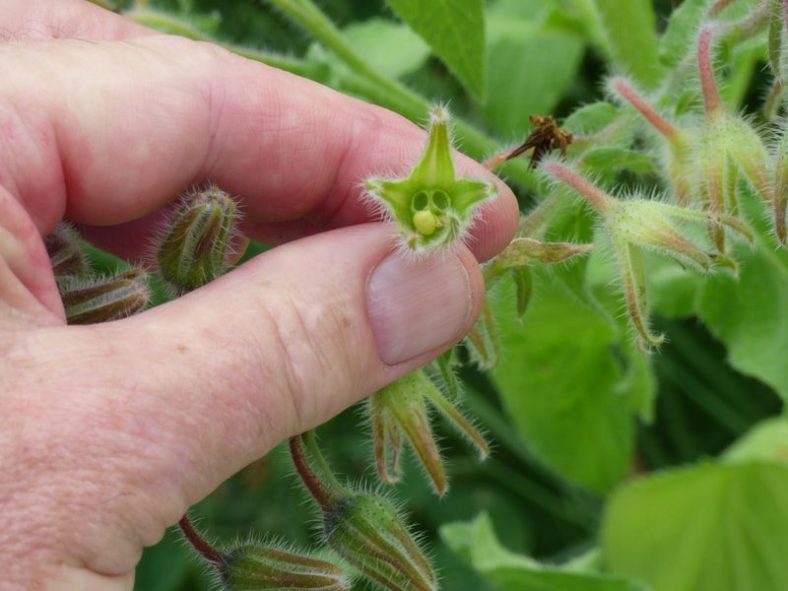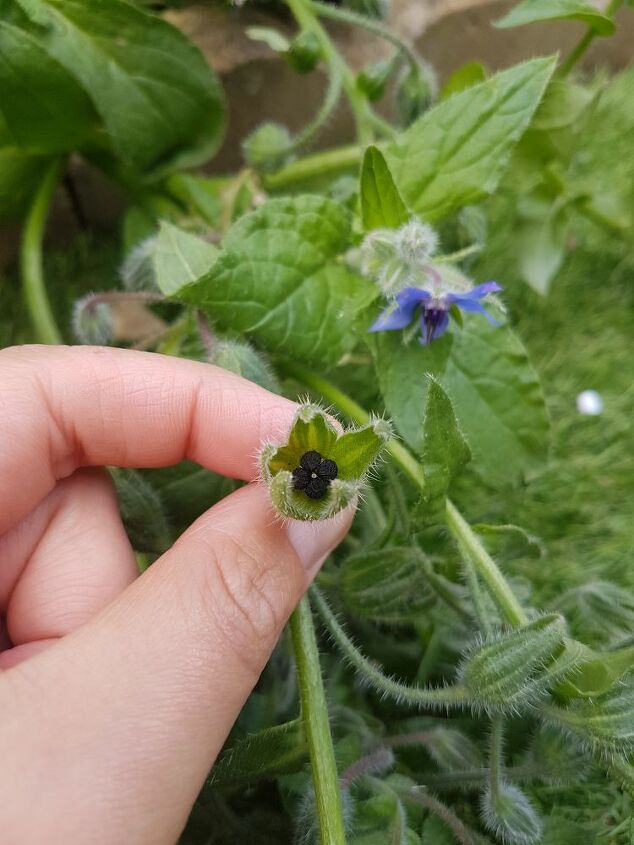To harvest borage seeds, wait until the flowers have wilted and turned brown, then cut off the flower heads and hang them upside down in a paper bag. Borage seeds can be harvested by shaking the dried flower heads over a clean surface or by gently rubbing them between your fingers.
Borage (Borago officinalis) is a beautiful herb often grown in gardens for its vibrant blue flowers and cucumber-like flavor. In addition to its culinary uses, borage seeds can be collected and saved for future planting. Harvesting borage seeds is a simple process that can be done once the flowers have gone to seed.

Credit: www.serpentinecommunitygarden.org
This article will guide you on how to successfully harvest borage seeds, ensuring a bountiful supply of plants for the next growing season.
How to Harvest Borage Seeds : Step by Step Guide
Selecting The Right Time For Harvesting Borage Seeds
Borage seeds can be harvested when the plant reaches the right maturity. It is important to select the right time for harvesting to ensure optimal seed quality. One indicator of borage plant maturity is peak flower production. When the plant is in full bloom, it is a good time to start considering seed harvest. Harvesting at this stage ensures that the seeds have developed fully and are ready for collection.
Another factor to consider is the weather conditions. Optimum weather conditions for seed harvest include dry and sunny days. Moisture can affect seed quality, so it is important to wait for a period of dry weather before harvesting the seeds. By keeping these factors in mind, you can ensure a successful borage seed harvest.
Preparing The Borage Plant For Seed Harvest
To harvest borage seeds successfully, it is important to prepare the borage plant for seed harvest. One way to do this is by cutting back the borage plant. This helps to promote new growth and encourages the plant to produce more seeds. Ensuring good air circulation around the plant is also crucial for seed production.
Adequate airflow helps to prevent diseases and mold from affecting the plant, which can hinder seed development. Another key factor in preparing the borage plant for seed harvest is regular watering and fertilization. Providing the plant with consistent moisture and nutrients helps to support seed production and ensures the plant remains healthy throughout the seed harvest process.
Techniques For Harvesting Borage Seeds
Harvesting borage seeds requires careful techniques to ensure optimal seed quality. Handpicking the ripe borage seedheads is a common method used by gardeners. These seedheads can be easily identified by their dry and brittle appearance, typically turning brown or gray in color. It is important to gently grasp the seedheads at the base and carefully twist them off the plant.
For larger-scale harvesting, pruning shears can be used to cut the seedheads, minimizing damage to the borage plant. After harvesting, it is essential to allow the seedheads to dry completely before extracting the seeds. Proper drying helps prevent mold or rot from affecting the seeds. Storing the collected seeds in a cool and dry place ensures their viability for future use.
Processing And Extracting Borage Seeds
Harvesting borage seeds is a rewarding task for gardeners. The process of processing and extracting these valuable seeds involves several steps. One of the first steps is drying the harvested borage seedheads. After the seedheads have been carefully cut from the plant, they should be placed in a dry and well-ventilated area. This allows the seeds to fully mature and dry out, making them easier to separate from the rest of the plant.
The next step in the process is threshing and removing the seedheads from the stems. This can be done by gently rubbing the seedheads between your hands or by using a sieve. Once the seedheads have been separated, the next step is cleaning and sieving the borage seeds. This removes any remaining plant material or debris, ensuring that the seeds are clean and ready for storage or further use.
Storing And Maintaining Borage Seeds
Proper storage containers are essential for preserving the viability of borage seeds. It is recommended to use airtight containers, such as glass jars or plastic containers with tight-fitting lids, to prevent moisture and air from entering. Keep in mind that glass jars are preferable as they are less prone to moisture buildup compared to plastic containers.
When storing borage seeds, it is important to maintain optimal conditions to extend their shelf life. Store the containers in a cool, dark, and dry place, away from direct sunlight and humidity. A pantry or a cool basement is an ideal location. This helps to protect the seeds from excessive heat and moisture, which could result in premature sprouting or mold growth.
Borage seeds have a relatively long shelf life, with an average viability of 2-3 years under proper storage conditions. To ensure the seeds remain viable, periodically check for signs of mold or moisture buildup. If any seeds appear discolored or show signs of mold, they should be discarded.
| Proper storage containers for borage seeds | Optimal storage conditions | Shelf life and viability of borage seeds |
|---|---|---|
| Glass jars or airtight plastic containers | Cool, dark, and dry place | 2-3 years under proper storage conditions |
Tips For Maximizing Borage Seed Harvest
Encouraging cross-pollination for increased seed production: Encourage cross-pollination in borage plants by planting them in close proximity to each other. This increases the chances of bees and other pollinators transferring pollen from flower to flower, leading to higher seed production.
Regular monitoring and inspection of borage plants: It is crucial to regularly monitor and inspect your borage plants throughout the growing season. Look for fully matured flowers and seed heads. Harvest these as soon as they are ready, as waiting too long may result in seed loss due to shattering.
Seed saving and propagation techniques: To save borage seeds, allow the seed heads to dry completely on the plant. Once dry, gently crush the seed heads to release the seeds. Store the seeds in a cool, dry place in airtight containers to maintain their viability. For propagation, sow the saved seeds in well-draining soil and keep them moist until germination occurs.
Utilizing Harvested Borage Seeds
Borage seeds are not only decorative but also have a range of culinary and medicinal uses. In the culinary world, the seeds are often used as a garnish or infused in oil to add a subtle cucumber-like flavor to dishes. They can be sprinkled over salads, soups, and desserts or used to flavor drinks like tea and cocktails.
In terms of medicinal and therapeutic applications, borage seeds are rich in essential fatty acids, particularly gamma-linolenic acid (GLA). This makes them beneficial for promoting healthy skin, reducing inflammation, and easing symptoms of certain conditions, such as arthritis and eczema. Additionally, borage seed oil supplements derived from the seeds are available and can be taken internally for various health benefits.
If you want to save borage seeds for future planting, it’s important to harvest them when they are fully mature and dry. This typically occurs when the flowers begin to fade and the plant starts forming seed heads. Simply cut the seed heads and allow them to dry completely before gently removing the seeds. Store the seeds in a cool and dark place in airtight containers to maintain their viability.
Final Thoughts: Enjoying The Fruits Of Your Borage Seed Harvest
Once you have successfully harvested your borage seeds, it’s time to enjoy the fruits of your labor. Borage plants not only add a touch of beauty to your garden with their vibrant blue flowers, but they also offer numerous benefits.
Celebrate the beauty and benefits of borage plants by sharing your seed harvest with others. Whether you give them as gifts to fellow gardeners or use them for community seed swaps, sharing borage seeds allows others to experience the joy of growing these plants themselves.
Continued care and cultivation of borage plants is important for their long-term success. Ensure they have adequate sunlight, well-drained soil, and regular watering. Borage is known for its self-seeding capabilities, so it’s important to remove any unwanted seedlings to maintain the desired growth of your plants.
Incorporate borage into your culinary adventures by adding the delicate flowers to salads, soups, or even freezing them in ice cubes for a decorative touch to your beverages. Additionally, the leaves can be used as a substitute for spinach or enjoyed in herbal teas.
Frequently Asked Questions On How To Harvest Borage Seeds
How Do You Gather Seeds From Borage?
To gather borage seeds, wait for the flowers to wither and dry. Then, gently crush the dried flowers and separate the seeds. Store the seeds in a cool, dry place for future use.
What Do Borage Seeds Look Like?
Borage seeds are small and round, resembling tiny black or brown beads. These seeds have a smooth texture and are commonly used in culinary dishes and for medicinal purposes.
How And When To Harvest Borage?
Harvest borage when the flowers are fully bloomed but haven’t turned brown. Cut the stems near the base using garden shears. It’s best to harvest early in the morning before the heat sets in.
Do I Need To Deadhead Borage?
No, deadheading borage is not necessary. Borage plants are self-seeding, so removing spent flowers won’t affect their growth. However, deadheading can improve the plant’s appearance and prevent unwanted spreading. Ultimately, it’s a matter of personal preference.
Conclusion
Harvesting borage seeds is a simple and rewarding process. By following the steps outlined in this guide, you can ensure a successful harvest and enjoy the numerous benefits of these versatile seeds. Remember to choose the right time for harvesting, handle the plant and seeds with care, and store them properly for future use.
With this knowledge, you’ll be able to grow your own borage plants and witness the beauty they bring to your garden. Happy harvesting!

